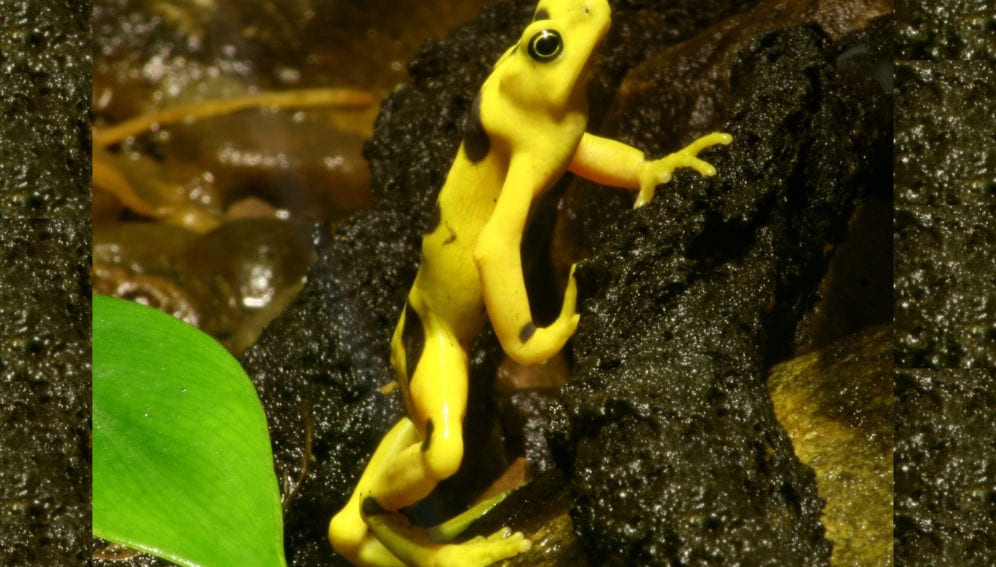29/03/19
Deadly fungal disease ‘caused greatest biodiversity loss ever recorded’

By: Ruth Douglas and Helen Mendes
Send to a friend
The details you provide on this page will not be used to send unsolicited email, and will not be sold to a 3rd party. See privacy policy.
An infectious fungal disease has driven mass amphibian die-offs worldwide and is responsible for the greatest loss of biodiversity attributable to a single pathogen ever recorded, a global study has found.
Chytridiomycosis, caused by two strains of the fungus Batrachochytrium dendrobatidis, or Bd, is responsible for the decline of at least 501 amphibian species, accounting for 6.5 per cent of all known amphibian species, according to the paper published in Science. Among those, 90 are confirmed or presumed extinct in the wild.
“Keeping amphibians alive is a matter of economics and public health.”
Lucas Forti – Federal University of Bahia, Brazil
The disease is contributing to the Earth’s sixth mass extinction, the report states, with the findings placing it among the world’s most destructive invasive species.
The study, which is the first global assessment of the impact of chytridiomycosis, highlights how global trade in wildlife has facilitated the rapid spread of the disease.
Amphibians are sold in restaurants or as pets, creating a “functional Pangaea” for infectious diseases, effectively breaking down geographical barriers that once stopped the dispersal of organisms, the paper’s authors explain.
“The unprecedented lethality of a single disease affecting an entire vertebrate class highlights the threat from the spread of novel pathogens in a globalized world,” the report states.
The Bd fungus infects the keratinized skin that amphibians develop when they mature and transition from water to land. The resulting chytridiomycosis prevents the amphibian from properly regulating the flow of electrolytes and fluids through its skin, usually leading to heart failure within a few weeks.
The report says the spread of the disease has impinged not only on biodiversity but also on human activities linked to the declining species.
The pharmaceutical industry, for example, uses chemical compounds produced by certain amphibians to make medicines. When a species disappears, the opportunity to use chemicals found in those animals for research also disappears.
Amphibians are also important for the control of agricultural pests.
Lucas Forti, an ecology and biomonitoring researcher at Federal University of Bahia, Brazil, told SciDev.Net: “When we lose amphibians in nature, agricultural pests increase and we have to use more pesticides, poisoning the environment and making agriculture more expensive. Keeping amphibians alive is a matter of economics and public health.”
Because they feed on insects, amphibians also control vectors of diseases such as zika, chikungunya, yellow fever and others transmitted by mosquitoes, added Forti, who did not participate in the research.
The study was carried out by 41 researchers from 36 institutions from 16 countries, who used retrospective evidence for their analysis because many species declined before the discovery of the disease in 1998.
“We relied on material deposited in museums and other people's collections,” Felipe Toledo, researcher of the department of animal biology at the University of Campinas University, in Brazil, and one of the authors of the study, told SciDev.Net.
Since most of the decline happened in the 1980s – in Central and South America and Australia – researchers gathered historical data for each species to reach their conclusions.
“One species was being collected up until a certain year, and after that, nobody saw it anymore. So we could see which species had disappeared throughout the world,” Toledo explained.
For Forti, this study confirms what was already suspected by conservation scientists: “Amphibians are the most endangered vertebrates on the planet”.Authors of the report say chytridiomycosis remains an ongoing threat which must be dealt with through better regulations on the global trade of amphibians.
Whereas Europe only buys frozen frog meat, Brazil sells live frogs to restaurants in the United States. “This is bad, because we export the fungus with the frogs, and data shows that fungi of Brazilian lineage were exported to the US,” said Toledo.
Forti agrees that more attention needs to be paid to biosafety measures that can reduce the risk of introducing these pathogens. “Regulation and enforcement of rules on the trade of native plants and meat need to improve,” he said.
This piece was produced alongside SciDev.Net’s Latin America and Caribbean edition.
Scientists from FAPESP, a donor of SciDev.Net, participated in the study published in the journal Science.













